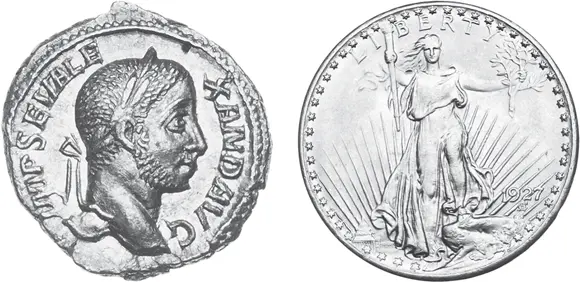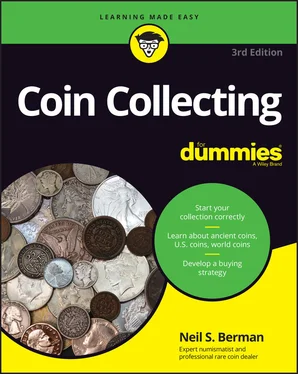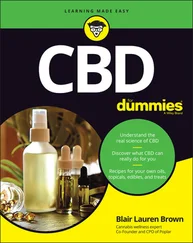Neil S. Berman - Coin Collecting For Dummies
Здесь есть возможность читать онлайн «Neil S. Berman - Coin Collecting For Dummies» — ознакомительный отрывок электронной книги совершенно бесплатно, а после прочтения отрывка купить полную версию. В некоторых случаях можно слушать аудио, скачать через торрент в формате fb2 и присутствует краткое содержание. Жанр: unrecognised, на английском языке. Описание произведения, (предисловие) а так же отзывы посетителей доступны на портале библиотеки ЛибКат.
- Название:Coin Collecting For Dummies
- Автор:
- Жанр:
- Год:неизвестен
- ISBN:нет данных
- Рейтинг книги:4 / 5. Голосов: 1
-
Избранное:Добавить в избранное
- Отзывы:
-
Ваша оценка:
- 80
- 1
- 2
- 3
- 4
- 5
Coin Collecting For Dummies: краткое содержание, описание и аннотация
Предлагаем к чтению аннотацию, описание, краткое содержание или предисловие (зависит от того, что написал сам автор книги «Coin Collecting For Dummies»). Если вы не нашли необходимую информацию о книге — напишите в комментариях, мы постараемся отыскать её.
Coin Collecting For Dummies,
numismatics
Coin Collecting For Dummies
Coin Collecting For Dummies — читать онлайн ознакомительный отрывок
Ниже представлен текст книги, разбитый по страницам. Система сохранения места последней прочитанной страницы, позволяет с удобством читать онлайн бесплатно книгу «Coin Collecting For Dummies», без необходимости каждый раз заново искать на чём Вы остановились. Поставьте закладку, и сможете в любой момент перейти на страницу, на которой закончили чтение.
Интервал:
Закладка:
Specialty clubs: Join a specialty club. Meet collectors who share your interests by joining specialty clubs such as the Bust Half Nut Club ( https://www.busthalfprices.com/bhnc.php ), Early American Coppers ( http://eacs.org ), and the Colonial Coin Collectors Club ( https://colonialcoins.org ). Also, be sure to attend their annual meetings, usually held in conjunction with the ANA’s annual convention.
Don’t be afraid to ask questions. Many coin dealers and most collectors are extremely helpful people who are willing to answer your questions. In my opinion, there’s no such thing as a stupid question in numismatics; we were all beginners at one time. That said, don’t expect to walk up to a coin dealer at a busy show and strike up a conversation, either: A busy dealer can’t drop everything they’re doing at a coin show to answer an intricate question. Be considerate of the dealer’s time.
Affecting a Coin’s Value
One of the greatest misconceptions about coins concerns their value. Given a choice, many noncollectors will pick a 2,000-year-old Roman denarius over a U.S. $20 gold piece any day, even though the denarius is worth $50 compared with $2,000 for the $20 gold piece (see Figure 3-1). Age seems to be an important factor to noncollectors; in their minds, the older a coin is, the more valuable it must be. Therefore, a 2,000-year-old coin must be worth a million bucks! Nothing could be further from the truth.

FIGURE 3-1:Roman denarius (left) or $20 gold piece (right): Which do you prefer?
 Several factors affect the value of a coin: rarity, demand (or popularity), supply, condition, and external market factors. Any one of these factors can be significant by itself, or it may require some help from one of the other factors. A coin may be common in low grades, indicating a low rarity, but in high grades, the same coin may be very rare, making it what is known as a condition rarity. In such a case, the value of the coin makes a huge jump in price as it moves from a lower grade to a higher grade.
Several factors affect the value of a coin: rarity, demand (or popularity), supply, condition, and external market factors. Any one of these factors can be significant by itself, or it may require some help from one of the other factors. A coin may be common in low grades, indicating a low rarity, but in high grades, the same coin may be very rare, making it what is known as a condition rarity. In such a case, the value of the coin makes a huge jump in price as it moves from a lower grade to a higher grade.
Age: Good for wine, good for coins?
Age has little or no effect on the value of a coin. Many coins from the past 20 years are much more valuable than coins from 2,000 years ago. Certainly, time allows coins to become better dispersed throughout the collecting community and the world, making them a little more difficult to find. But just because a coin is old doesn’t mean that it’s rare or valuable.
Condition: Pumping them up
The condition of a coin is a hugely important factor in determining its price. The difference in a single point on the grading scale can equate to a difference of thousands of dollars in value. Because of the intense competition to own the finest known example of a given date, a large premium can be attached to the very best coins.
Take the 1953-S Franklin half dollar as an example. This coin is very common in low grades, worth perhaps only the value of the silver it contains. Even in Uncirculated condition, you can buy a nice-looking example for around $100. But well-struck, high-grade examples are extremely rare and more valuable. How valuable? In January 2001, the finest certified 1953-S Franklin half dollar came on the market and sold at auction for a whopping $69,000! If you think that price is crazy, you may very well be right, but remember that at least one underbidder wanted the coin almost as badly as the winner did.
When Dr. William Sheldon devised his 70-point pricing scale with numismatist Walter Breen in the 1940s, he noticed that price and condition followed each other rather closely (at least, in the large cents he collected and studied). Sheldon saw that collectors considered the finest example of any date to be worth 70 times the value of the worst example. A Very Fine example may be worth 20 to 30 times the value of the worst example, and an About Uncirculated coin may be worth 50 to 55 times as much. Using this information, Sheldon and Breen created a scale to show the relationship between the grades and prices of large cents. Later, the coin market morphed this pricing scale into a grading system that was applied to other series of U.S. coins, even though inflation had already destroyed the relationship between price and condition. Today, the Sheldon-Breen grading scale is the bedrock of U.S. numismatics, and the number 70 is universally recognized as the pinnacle of quality.
THE HOARD FACTOR
A hoard is a large group of coins, usually discovered many years after they were made, coming onto the market at the same time.
In the 1960s, the 1903-O silver dollar (struck at the New Orleans mint) was considered to be one of the great rarities of the Morgan dollar series despite a mintage of 4,450,000 pieces. For some reason, there simply weren’t enough coins to supply collector demand. Then, one day, the U.S. Treasury Department discovered a hoard of 1903-O silver dollars while cleaning out its vaults. Overnight, the price of a 1903-O silver dollar plunged as the supply increased to satisfy the existing collector demand.
The 1996 recovery of gold coins from the S.S. Brother Jonathan and the S.S. Central America shipwrecks dramatically affected the prices of certain dates in the Double Eagle denomination. Once considered to be a rarity in high grade, the 1857-S $20 is now one of the most common early gold coins, thanks to the hoard found on the Central America. Hoards account for the low prices of many ancient Greek and ancient Roman coins, as metal detectors and construction projects continue to turn up clay jars filled with old coins.
The size of a hoard and the way the coins are sold into the coin market determine the effect on prices. In the 1970s, a vast hoard of more than 600,000 U.S. silver dollars, once owned by the eccentric LaVere Redfield, began filtering into the market. The sheer size of the hoard threatened to kill prices because there wasn’t enough money in the coin market to absorb all the coins at the same time. But shrewd control of the pricing and distribution of the hoard kept prices from falling. In fact, some experts argue that interest in silver-dollar collecting actually increased because of the intelligent way that the hoard was distributed.
Demand: Demanding high dollar
Demand is an important factor in determining the value of a coin. High demand increases values, and low demand hurts values. Two coins of identical rarity may enjoy wildly different values, depending on the demand for each coin. A common coin in a series with many active collectors (such as silver dollars) is always more valuable than a common coin in a series that collectors largely ignore (such as Jefferson-head nickels).
HOARDING WASHINGTON CARVER
A favorite coin is the 1951 Washington Carver commemorative half dollar (see figure). As an example, in MS-65 condition, the Professional Coin Grading Service (PCGS) and Numismatic Guarantee Corporation (NGC) has certified only 473 examples combined, yet the current bid price is only $65. Theoretically, I could buy up every certified MS-65 example for $30,745, but I know from experience how hard it is to find this coin at coin shows and in other dealers’ inventories. If I bought only 10 or 20 pieces, the price would start going up. Just a small increase in the demand for this coin would translate into a big jump in price. Should I do it? Would you?
Читать дальшеИнтервал:
Закладка:
Похожие книги на «Coin Collecting For Dummies»
Представляем Вашему вниманию похожие книги на «Coin Collecting For Dummies» списком для выбора. Мы отобрали схожую по названию и смыслу литературу в надежде предоставить читателям больше вариантов отыскать новые, интересные, ещё непрочитанные произведения.
Обсуждение, отзывы о книге «Coin Collecting For Dummies» и просто собственные мнения читателей. Оставьте ваши комментарии, напишите, что Вы думаете о произведении, его смысле или главных героях. Укажите что конкретно понравилось, а что нет, и почему Вы так считаете.












